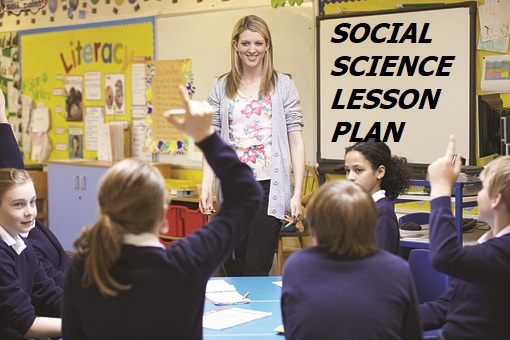How To Make Your Social Science Lesson Plan Effective?
How to make your Social Science Lesson Plan effective? Can you change the perception with your Social Science Lesson Plan? Is it possible?
Yes of course. An effective Social Science lesson plan is essential because it provides a structured and organized approach to teaching
complex and nuanced concepts. Social science is an interdisciplinary field that examines human behavior, societies, and institutions, and
covers a broad range of topics such as History, Economics, Geography, and Civics.
Thus, an effective lesson plan helps educators to convey this knowledge to students in a meaningful and engaging way.
A well-designed lesson plan takes into account the learners’ needs, abilities, and interests, and it also considers the use of appropriate
instructional materials and teaching strategies. By using an effective social science lesson plan, teachers can help students to develop critical
thinking skills, build their knowledge and understanding of the world around them, and become active and engaged citizens. Overall, a well-
crafted social science lesson plan is an important tool for promoting quality teaching and learning in the social sciences.
Outline Of The Process Of Making An Effective Social Science Lesson Plan
Determine the learning objectives
Start by identifying the specific learning objectives you want your students to achieve.
Your objectives should be clear, concise, and measurable.
For example, a learning objective for a lesson on Ancient Rome could be:
“Students will be able to describe the social hierarchy of Ancient Rome.”
Choose a topic
Choose a topic that aligns with your learning objectives and is relevant to your students’ lives.
For example, if your learning objective is to teach about the social hierarchy of Ancient Rome,
your topic could be “The social classes in Ancient Rome.”
Gather materials
Gather materials that will help you teach the topic effectively.
This could include books, videos, primary sources, maps, or any other relevant resources.
Plan the lesson structure
Plan how you will introduce the topic, how you will engage the students, and how you will assess their learning.
A typical lesson structure might include an introduction, a mini-lecture or discussion, an activity or assignment, and a wrap-up.
Develop activities
Develop activities that will help your students achieve the learning objectives.
However, these could be individual or group activities, written or oral assignments, or any other type of activity that aligns with your learning
objectives.
Assess learning
Develop assessments that will measure whether students have achieved the learning objectives.
This could include quizzes, tests, essays, or other types of assessments.
Reflect and revise
After teaching the lesson, reflect on what worked well and what didn’t.
Revise the lesson plan as needed to make it more effective for future use.
Remember, a well-prepared lesson plan should be flexible and adaptable to your student’s needs and interests.
With practice and experience, you can refine your lesson planning process to create effective and engaging social studies lessons.
How To Write Learning Objective In Social Science Lesson Plan
Writing a clear and specific learning objective is an essential component of a social science lesson plan.
Here are some steps to help you write effective learning objectives:
Start with an action verb
Use an action verb to start your learning objective, such as describe, analyze, compare, explain, or evaluate.
The verb should describe what the student is expected to do or demonstrate after the lesson.
Be specific
Make sure your learning objective is specific and measurable.
Avoid vague or general terms that could lead to confusion or misinterpretation.
Consider the cognitive level
Consider the cognitive level of the learning objective.
Social science lessons can involve different levels of cognitive skills, such as knowledge, comprehension, application, analysis, synthesis, and
evaluation.
Choose a cognitive level that is appropriate for the grade level and prior knowledge of your students.
Connect to the topic
Connect the learning objective to the topic you are teaching.
Make sure the objective relates to the key concepts, themes, or skills that students will learn in the lesson.
Example
For example, if your social science lesson is about the Civil War, a well-written learning objective might be:
“Students will be able to analyze the causes of the Civil War and evaluate the impact of these causes on the political and social landscape of
the United States.”
By following these steps,
you can create effective and measurable learning objectives for your social science lesson plan that will help guide your teaching and
assessment.
What Should Be Included In Specific Objectives in Social science Lesson Plan?
A specific objective in a social science lesson plan should be a clear and concise statement that describes what the students will be able to do
or demonstrate at the end of the lesson.
Here are some key components that should be included in a specific objective:
Action verb
The objective should start with an action verb that describes what the student is expected to do, such as “identify,” “analyze,” “compare,”
“discuss,” or “evaluate.”
Learning outcome
The objective should state the specific learning outcome that the student will achieve.
This should be clear, specific, and measurable. For example,
“Students will be able to identify the three branches of the U.S. government” is a clear and specific learning outcome.
Assessment criteria
The objective should describe how the student will be assessed.
This could be through a quiz, test, discussion, or another assessment method.
The assessment criteria should be specific and measurable so that both the teacher and the student can determine if the objective has been
achieved.
Relevance to the topic
The objective should be relevant to the topic being taught.
It should clearly connect to the key concepts, themes, or skills that students will learn in the lesson.
Level of cognitive complexity
The objective should be written at a level of cognitive complexity.
It should be appropriate for the grade level and prior knowledge of the students.
This could include knowledge, comprehension, application, analysis, synthesis, or evaluation.
Here is an example of a specific objective for a social science lesson:
Objective:
Students will be able to analyze the causes of the Great Depression and evaluate the impact of these causes on the U.S. economy.
By including these key components, you can create a specific and effective objective that will guide your teaching and assessment in the
social science lesson plan
Ideas For Conducting Classroom Activities in Social science Lesson Plan
Here are some ideas for conducting classroom activities in a social science lesson plan:
Debate
Divide students into groups and assign each group a different topic related to the social science lesson.
Students can then research and prepare their arguments, and then participate in a debate.
Role-play:
Have students assume the roles of historical figures or characters in social science scenarios.
Role play can help bring the content to life and make it more engaging.
चार रोल प्ले गतिविधियां जो कक्षा में पढ़ाई को जोड़ें वास्तविक जीवन से
Case studies
Use case studies to encourage students to apply the concepts they have learned in the lesson to real-world scenarios.
You can provide them with a case study, or they can research and present their own.
Group projects
Assign group projects.
Your students require to research and present information on a specific topic related to the social science lesson.
This can encourage teamwork and collaboration while helping students to deepen their understanding of the content.
Project On Tsunami: 13 Pages You Must Include In Your Disaster Management Project
Simulations
Create simulations of historical events or social science scenarios.
For example, a mock trial or a model UN meeting, to give students a hands-on learning experience.
Current events
Assign current events related to the social science lesson and have students present their findings to the class.
This can help students see how the concepts they are learning apply to the world around them.
Field trips
Take students on field trips to museums, historical sites, or other relevant locations to help them see the content in a real-world context.
Games
Use games to help reinforce the concepts learned in the social science lesson.
For example, students can play Jeopardy or Kahoot to review key terms and concepts.
Multimedia presentations
Students can create multimedia presentations.
Such as videos, infographics, or podcasts to demonstrate their understanding of the social science content.
This can help students develop their creative and technical skills while also deepening their understanding of the content.
Guest speakers
Invite guest speakers who work in fields related to the social science lesson to speak to the class.
This can help students see how the content they are learning applies to real-world careers and opportunities.
What To Include In Learning Outcome?
When creating a learning outcome for a social science lesson plan, you should consider including the following elements:
Specific Content
Identify the specific topic or concept that students will learn in the lesson.
Be specific about the content to be covered, such as key ideas, concepts, events, people, or processes.
Action Verb
Use an action verb that describes what students should be able to do or demonstrate after the lesson.
Examples of action verbs that can be used in social science lesson plans include analyzing, comparing, evaluating, explaining, identifying,
interpreting, and summarizing.
Performance Criteria
Set clear performance criteria that define the level of mastery students are expected to achieve.
These can be measurable criteria such as accuracy, speed, quality, or creativity, depending on the learning outcome and the task.
Context
Provide context or real-world relevance for the learning outcome.
Explain why the content is important or relevant to students’ lives, and how it connects to other social science concepts or disciplines.
Assessment
Identify the assessment method that will be used to evaluate student mastery of the learning outcome.
This could include a quiz, essay, project, presentation, or other assessment tools that align with the learning outcome.
Here’s an example of a well-crafted learning outcome for a social science lesson:
“Students will be able to analyze the causes and effects of the Civil War by identifying and summarizing key events and figures and evaluating
the role of slavery in the conflict. Students will demonstrate mastery by completing a written essay that synthesizes their analysis and
provides context for the significance of the Civil War in American history.”
What should I Mention In Remedial Measures?
When developing remedial measures for a social science lesson plan, you should consider including the following elements:
Identify the areas of weakness
Start by identifying the specific areas of weakness or difficulty that students are experiencing.
This can be done through formative assessments, class observations, or student feedback.
Provide additional resources
Consider providing additional resources to support students’ learning.
These can include online resources, textbooks, study guides, or other materials that provide alternative explanations or examples.
Offer individual or small group instruction
Consider offering individual or small group instruction to provide personalized attention and support for students who are struggling.
This can be done during class time or through after-school tutoring.
Use differentiated instruction
Consider using differentiated instruction to address the needs of students with different learning styles or abilities.
This can include offering different activities or assignments that align with students’ strengths and interests.
Re-teach the material
Consider re-teaching the material in a different way to provide additional clarity and reinforce key concepts.
This can include using visual aids, hands-on activities, or other instructional strategies that help students engage with the material.
Monitor progress and adjust instruction
Finally, be sure to monitor student progress and adjust instruction as needed.
Use formative assessments to evaluate student understanding.
Adjust instruction to address areas of continued difficulty or misunderstanding.
Here’s an example of remedial measures that can be included in a social science lesson plan:
“Remedial measures for students struggling with the concept of democratic principles will include offering additional online resources and
textbooks, providing small group instruction during class time, and using differentiated instruction strategies, such as offering different
activities based on students’ interests and abilities. Additionally, the teacher will re-teach the material in a different way using visual aids and
hands-on activities to reinforce key concepts. Progress will be monitored through formative assessments, and instruction will be adjusted as
needed to address areas of continued difficulty or misunderstanding.”
5 common methods to be mentioned in social science lesson plan for revision

SOCIAL SCIENCE LESSON PLAN
What is the Pair and share method?
Pair and Share is a cooperative learning technique that involves two students working together to share their ideas, knowledge, and
understanding about a topic or concept. In this method, the teacher first gives students a question or prompt related to the lesson or topic,
and then students are paired up with a partner.
Once paired up, students take turns sharing their thoughts, ideas, and knowledge with their partners.
This allows each student to hear and learn from their partner’s perspectives, while also allowing them to practice their own communication
skills.
Pair and Share is a simple but effective method that encourages active participation and engagement among students, while also promoting
collaboration and teamwork. It can be used at various stages of a lesson, such as to review a topic, generate ideas, or reflect on a lesson.
Class VI Social Science Lesson Plan For The Month Of April-May – Activity Based
Each One Teach One Method
Each One Teach One is a peer-to-peer learning method where a student who has gained mastery or knowledge on a topic, concept or skill, is
paired with another student who is less knowledgeable. The student who has a better understanding of the topic or skill then teaches and
shares their knowledge with the other student in a one-on-one or small group setting.
This method can be used in a variety of educational settings, including classrooms, after-school programs, and informal learning
environments. It is particularly effective for building students’ confidence, reinforcing concepts, and encouraging active participation.
Each One Teach One method is a student-centered approach that promotes learning through interaction and collaboration. It provides an
opportunity for students to develop leadership skills, as well as communication and interpersonal skills, as they engage in the teaching and
learning process. By sharing their knowledge and skills, students can help each other to deepen their understanding of the topic or skill, while
also fostering a sense of mutual support and respect.
Blended Learning
Blended learning is an instructional approach that combines traditional face-to-face classroom teaching with online or digital learning
experiences. This approach has been gaining popularity in recent years, and it can be particularly effective in social science classes.
Here are some ways that blended learning can be incorporated into a social science class:
Online readings and resources
In a social science class, there is often a lot of reading involved. By providing online readings and resources, students can access the materials
at their own pace and review them as needed. This also frees up class time for more interactive activities and discussions.
Online discussions and forums
Online forums and discussion boards can be used to facilitate class discussions and debates.
This allows students to share their thoughts and perspectives on topics related to the class, even if they are not physically present in the
classroom.
Online quizzes and assessments
Blended learning can also be used for formative and summative assessments. Online quizzes and assessments can provide immediately
feedback to students and help teachers to identify areas where students may need additional support.
Flipped classroom model
In a flipped classroom model, students are introduced to new content online and then come to class to apply what they have learned.
In a social science class, this could involve watching videos, reading articles, or exploring primary source documents online before class, and
then engaging in discussions, debates, and other activities during class time.
Collaborative online projects
Blended learning can also facilitate collaborative projects that extend beyond the classroom.
Students can use online tools to work together on research projects, presentations, and other assignments that involve teamwork and
communication.
Overall, blended learning can provide social science students with more flexibility and opportunities for engagement and collaboration, while
also helping them to develop the technology skills they will need in the modern workforce.
Class VII Social Science Lesson Plan For The Month Of April – May with Classroom Activities
Game-Based Learning
Game-based learning is an instructional approach that uses games or game-like elements to teach content and skills.
It can be a highly effective approach in social science classes, as it can help students to better understand complex concepts and engage with
historical events and social issues in a more immersive and interactive way.
Here are some ways that game-based learning can be incorporated into a social science class:
Historical simulations
Historical simulations can provide students with a hands-on way to experience historical events and social issues.
For example, students can role-play as characters from a particular era or take on the role of decision-makers in a historical event.
This can help students to better understand the context and consequences of historical events and how they relate to the present day.
Class VIII Social Science Lesson Plan – Activity Based For The Month Of April – May
Educational games
There are a variety of educational games that can be used in social science classes, including games that teach geography, economics, and
civics. These games can be used to reinforce key concepts and skills, while also providing a fun and engaging way for students to learn.
Gamification of learning activities
Gamification involves adding game-like elements to learning activities to increase engagement and motivation.
For example, a teacher might award points or badges for completing assignments or mastering certain skills or create a leaderboard to
encourage healthy competition among students.
Role-playing and decision-making games
Role-playing and decision-making games can be used to help students understand complex social issues and make decisions based on limited
information. For example, students could role-play as political leaders or activists and debate the pros and cons of a particular policy or
decision.
International Date Line – why it is not straight?
Digital storytelling
Digital storytelling involves using digital tools to create stories or narratives.
In a social science class, students could use digital tools to create a historical narrative, a biography of a famous figure, or a story that
explores a social issue.
Overall, game-based learning can provide social science students with a more engaging and immersive learning experience, while also
helping them to develop critical thinking, decision-making, and collaboration skills.
Experiential Learning
Experiential learning is an approach to education that emphasizes hands-on, real-world experiences as a way of learning. Rather than relying
on solely on classroom lectures or textbook readings, experiential learning encourages students to actively engage with the world around
them and to learn by doing.
There are many different ways that experiential learning can be incorporated into the classroom, such as field trips, internships, and service
learning projects. In a social science class, for example, students might visit a museum or historical site, interview community members
about a local issue, or participate in a simulation of a political or economic system.
Experiential learning can be highly effective because it helps students to connect what they are learning to real-world contexts and develop
practical skills that are relevant to their future careers. It also encourages creativity, critical thinking, and problem-solving, as students are
challenged to apply their knowledge in new and unfamiliar situations. Overall, experiential learning can provide students with a better-
rounded and meaningful educational experience, and help to prepare them for success in the real world.
How To Write Learning Outcome?

Social Science Lesson Plan
Steps you can follow to write learning outcomes
Here are some steps you can follow to write learning outcomes for a social science lesson plan in points:
Firstly, Identify the topic of your lesson. For example, the topic could be “The American Revolution.”
Secondly, decide on the level of knowledge you want your students to gain.
For example, you might want your students to be able to recall facts about the causes of the American Revolution, or you might want your
students to be able to analyze the impact of the American Revolution on American society.
Thirdly, write your learning outcome as a clear and specific statement that describes what you want your students to learn. For example:
- Students will be able to identify and describe the main causes of the American Revolution.
- Students will be able to analyze the impact of the American Revolution on American society.
- Students will be able to compare and contrast the different perspectives of the Patriots and the Loyalists during the American Revolution.
Fourthly, use action verbs that describe the level of knowledge you want your students to gain. Some common action verbs you can use for social science lesson plans include:
- Identify
- Describe
- Analyze
- Compare
- Contrast
- Evaluate
- Synthesize
- Apply
Finally, make sure your learning outcome is measurable and observable, so you can assess whether your students have achieved it.
For example, you might assess your students’ learning outcomes by asking them to write an essay, complete a worksheet, or participate in a
class discussion.
Here are some examples of learning outcomes for a social science lesson plan on the American Revolution, written in points:
- Students will be able to identify and describe the main causes of the American Revolution.
- Students will be able to analyze the impact of the American Revolution on American society.
- Students will be able to compare and contrast the different perspectives of the Patriots and the Loyalists during the American Revolution.
- Students will be able to evaluate the significance of the American Revolution in the context of world history.
- Students will be able to apply the concepts of taxation and representation to current political issues.





0 Comments